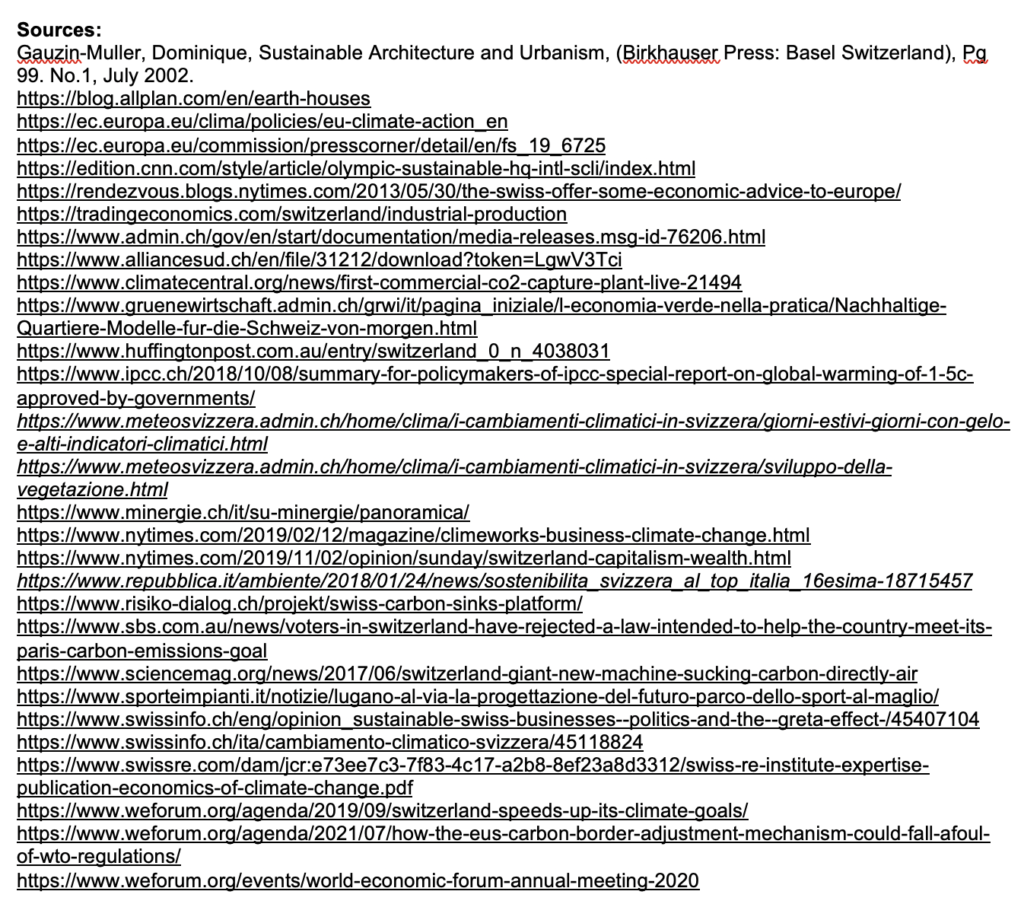The climate crisis began to take precedence in an international context with the dawn of the new millenia. Global warming and climate change quickly became commonplace in the vernacular of political debate, along with the blossoming notion of sustainability. As the years stretched on and little effective solution was achieved, the need to devise a system of collective action became paramount. In 2015, the Paris Climate Agreement was created, referred to as “an agreement of conviction, solidarity and long-term vision.” A legally binding pathway signed by 195 countries, the PCA serves to unite member states in the objective to keep global warming to below 2℃ above pre-industrial levels. The IPCC (Intergovernmental Panel on Climate Change) has since produced a report revising this target to 1.5℃ of warming, as climate models predict an overwhelming contrast between the projected environment at 1.5℃ versus 2℃ warmer. In terms of conviction and long-term vision, Switzerland emerges as a shining example of a nation dedicated to climate action. Predominantly focused on negative emissions production and innovative pursuit of this end, Swiss policy framework diverges from the crowd as a frontrunner in sustainability and technological advancements. As a country synonymous with economic prosperity and modernity, its climate response follows suit, largely through the implementation of systems, strategy and emissions criteria across all industries. In 2015, Switzerland was the first country to commit to cutting its CO2 emissions by 2030 and deliver a plan to this effect to the UN before the Paris Climate Deal was officially adopted. In 2018, Switzerland was nicknamed “the homeland of the green,” having arrived at first place in the Environmental Performance Index where this year it remains in third place – an impressive result for a country with booming industrial and construction sectors. As a nation which boasts collective action on climate change from both private and public sectors, and with its major strides in the field of sustainability, Switzerland’s well-earned epithet of a “healthy, happy, capitalist utopia” is more fitting than ever.
Alongside CO2 sinks such as forests, soil deposits and innovative technologies across industries and research, Switzerland is notably investing in negative emissions as its key approach to climate neutrality. In light of the systemic risks of construction and industrial production as demonstrated by climate scientists, this approach has had a particularly transformative effect on the Swiss built environment. However, the Swiss climate agenda is threatened by its private sector which is inextricably linked to the economic output of carbon-intensive products. In fact, the Swiss financial sector has had the greatest impact of all, producing twenty times more emissions than the entire country. The wider spread of residential areas in Switzerland has similarly devastated the natural environment, as it is divided on a mass scale to create agricultural land and urban development zones. The amount of land loss increased by 23% between 1985 and 2009, a figure which contradicts Swiss targets. To this, Switzerland has demonstrated both the need for, and the efficiency of, coordinated global policy action between public and private sectors and across industries. The Swiss policy framework exemplifies the vested potential of corporate standards to increase transparency and accountability of enterprises. Among the first of Swiss efforts of this calibre was their introduction of the Minergie Standard in 2009. This standard included targets for the use of renewable energy and energy/heating consumption in the housing sector during urban development projects. The aim was to promote these criteria and encourage their implementation in housing and service sectors, transforming these industries immutably, as development soon became inseparable from climate-focused initiatives. In 2000, the Swiss government announced the application of this standard to all federal buildings and state-subsidized projects, drawing a symbolic line in the sand to emphasise that Switzerland was taking its climate aims in the built environment seriously. In 2016, this idea was consolidated and optimized through the creation of the Swiss Sustainable Construction Standard.
To further transform its construction sector, Switzerland sought to establish certain technical and normative conditions which extended to waste management and the use of recyclable materials. Fifteen million tonnes of mineral construction waste is generated annually, a figure that was originally sent entirely to landfill each year. In response, the Federal Waste Ordinance was formed and tasked with the extraction of secondary raw and construction materials which are then processed and repurposed where possible. These efforts similarly ease the pressure on land use, by limiting space needed for landfill. With concerns for climate risks imposed by urban development taking precedence, the burgeoning frontier of Swiss sustainable architecture has gained popularity. The renowned architect Peter Vetsch is a pioneer in the field with his “earth houses”, created with eco-sustainable materials which use renewable energy sources, making it possible to halve heating costs and regular energy usage. The roofs of these houses also function as gardens and lawns, decreasing the need for space and land loss.
The Swiss Headquarters for the Olympic and Paralympic Games epitomises ecological efficiency in the built environment, situated on the scenic shores of Lake Geneva. The masterpiece was coined “the most sustainable building in the world” at least until June 2019 – with more than 95% of its materials reused or recycled. The building serves as a beacon of hope for climate solutions in the modernizing world and reflects the growing trend for eco-sustainable architecture. Rainwater is collected on site and used for plant irrigation and the building’s toilets, whilst the roof’s solar panels will produce enough electricity to power 60 Swiss households. Its 27,000 square foot plant covered green roof pays homage to Swiss earth houses of similar sustainable construction, designed to convey the kinetic energy of a snowboarder hurtling down a slope.
In 2017, Swiss company Climeworks opened the world’s first CO2 capture and storage facility in Zurich, making it the first to capture carbon commercially, selling it to buyers who use it as fertilizer and carbonate in soft drinks. As a long term goal, Climeworks aims to capture 1 percent of global annual carbon dioxide emissions by 2025. Carbon removal and storage constitute “negative emissions,” as Switzerland has recognised that these processes are among the few solutions to feasibly reduce its carbon emissions by 70-85% by 2050 as pledged. Negative emissions involve balancing out carbon levels by absorbing an equal amount from the atmosphere, through these technologies or planting trees. Air-captured CO2 is exceedingly versatile and can be combined with hydrogen to produce all sorts of fossil-fuel substitutes. At this stage, the issue lies in commercial profit of the plant and its owners hope to sell to larger agriculture or beverage companies. However, the potential of the carbon capture idea appears to be much more bigger-picture than any immediate profit from Coca-Cola. Climeworks and canadian company Carbon Engineering plan on producing synthetic fuel from air-captured CO2 one day, and have started lining up investors. The creators of Climeworks have already begun injecting captured carbon into rock formations deep underground beneath Reykjavik with plans to commercialize this as a service. This new method of carbon offset is breaking new ground in the field of carbon mitigation, creating a service for a market that doesn’t exist yet. However, perhaps these developments are occurring with great divine timing, with the European Commission set to release details of its proposed ‘carbon border adjustment mechanism’ (CBAM) this month. CBAM is theorized to involve emissions certificates as requirements for foreign imports, a new development in the EC’s “economic approach” to realizing the commitments of the EU’s Green Deal and central goal of climate neutrality by 2050. In Davos, in the Swiss canton of Grigioni, the World Economic Forum is held annually; where distinguished representatives of civil society gather to discuss global prospects. Suffice to say, Switzerland is well-positioned to promote sustainability and climate goals, which have remained at the forefront of discussions each year since 2000. Last year, the topic of discussion was titled “Stakeholders for a Cohesive and Sustainable World,” where the central objective was to track progress towards the Paris Agreement and EU Sustainable Development Goals.
In light of the ominous projections of the IPCC’s report on 1.5 degrees warming and the imminent arrival of CBAM’s conditions on world trade, there is a clear shift in rhetoric around climate action as a response. Naturally, CBAM has produced concerns for the future of world trade and international relations. Whilst Switzerland will be excluded from this mechanism thanks to its position in the European Economic area, Brazil, South Africa, India and China have expressed concerns that these certificates will unfairly discriminate against European imports of their products. Recent developments like CBAM coincide with the EU’s obligations to the World Trade Organisation and the European Green Deal, which devised a new industry policy based on “the circular economy”. Adopted in March 2020, this new deal aims to stimulate the development of climate neutral markets through an action plan to “modernise the EU’s economy.” Climate uncertainty has been similarly linked with economic insecurity by the Swiss Re Institute for climate change. In short, the shift around climate action has resulted in increased concern for the economic impact it will have. Global warming is posited by Swiss economists to cause a 10% decrease in global economic value if the Paris targets are not met and action continues on the same trajectory. However, it seems that this change of tack has been insufficient in placating the economic concerns of those who stand to lose immediately by shifting to sustainable solutions. Specifically, those who will be penalised by proposed levies and taxes on the use of carbon-intensive products. Just last month, Swiss voters narrowly avoided the government’s plan to introduce car fuel levies and taxes on flight tickets. The votes came in at 49% for and 51% against. As polarising as these kinds of fees are, the Swiss Government evidently did not anticipate this outcome as corporate criteria is central to their strategy of carbon offset. The bill was drafted by environmentalists who sought to reduce greenhouse gases to 1990 levels, and largely via fossil-fuel taxes and renewable energy resources and the result is a significant roadblock in progress.
Swiss political objectives in investing in favour of its population and thriving economy have complemented its response to climate change. It is through the promotion of policies which fit into this narrative of preserving social cohesion and its national identity as a modern, successful, prosperous country that Switzerland has achieved impressive innovations. Climate indicators and statistics reveal the ravaging effects of global warming on Switzerland, and particularly in the Alps, where ambient temperatures are steadily increasing. In Lucerne, the number of tropical days (where the maximum temperature reaches 30 degrees) has continuously increased in the past two decades in particular. According to the federal meteorological office, the effects of the global temperature increase will be felt everywhere; on growth of vegetation, the thinning of the ozone layer, days of frost. Up until this crucial point, Switzerland has faced these challenges effectively by cultivating a sense of social responsibility that is shared across industries. However, the prevailing concern remains that Switzerland is now snagging on its superficial achievements instead of pursuing transformative solutions that could cement its place as a global role model for sustainability and climate action.



